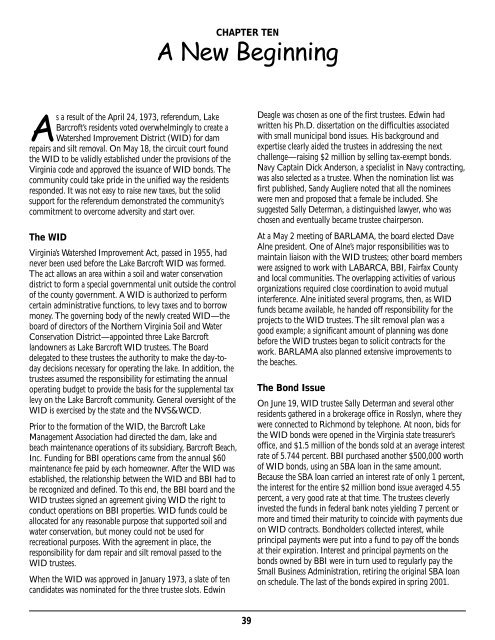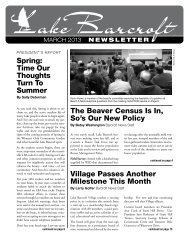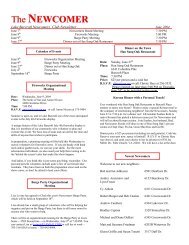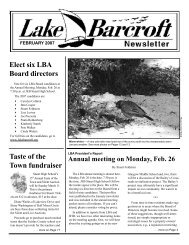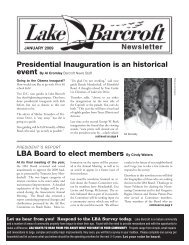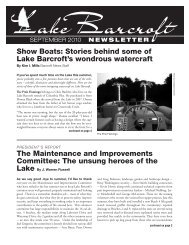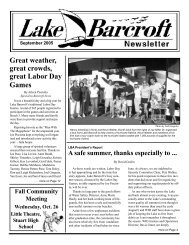Lake Barcroft History Book
Lake Barcroft History Book
Lake Barcroft History Book
You also want an ePaper? Increase the reach of your titles
YUMPU automatically turns print PDFs into web optimized ePapers that Google loves.
As a result of the April 24, 1973, referendum, <strong>Lake</strong><br />
<strong>Barcroft</strong>’s residents voted overwhelmingly to create a<br />
Watershed Improvement District (WID) for dam<br />
repairs and silt removal. On May 18, the circuit court found<br />
the WID to be validly established under the provisions of the<br />
Virginia code and approved the issuance of WID bonds. The<br />
community could take pride in the unified way the residents<br />
responded. It was not easy to raise new taxes, but the solid<br />
support for the referendum demonstrated the community’s<br />
commitment to overcome adversity and start over.<br />
The WID<br />
Virginia’s Watershed Improvement Act, passed in 1955, had<br />
never been used before the <strong>Lake</strong> <strong>Barcroft</strong> WID was formed.<br />
The act allows an area within a soil and water conservation<br />
district to form a special governmental unit outside the control<br />
of the county government. A WID is authorized to perform<br />
certain administrative functions, to levy taxes and to borrow<br />
money. The governing body of the newly created WID—the<br />
board of directors of the Northern Virginia Soil and Water<br />
Conservation District—appointed three <strong>Lake</strong> <strong>Barcroft</strong><br />
landowners as <strong>Lake</strong> <strong>Barcroft</strong> WID trustees. The Board<br />
delegated to these trustees the authority to make the day-today<br />
decisions necessary for operating the lake. In addition, the<br />
trustees assumed the responsibility for estimating the annual<br />
operating budget to provide the basis for the supplemental tax<br />
levy on the <strong>Lake</strong> <strong>Barcroft</strong> community. General oversight of the<br />
WID is exercised by the state and the NVS&WCD.<br />
Prior to the formation of the WID, the <strong>Barcroft</strong> <strong>Lake</strong><br />
Management Association had directed the dam, lake and<br />
beach maintenance operations of its subsidiary, <strong>Barcroft</strong> Beach,<br />
Inc. Funding for BBI operations came from the annual $60<br />
maintenance fee paid by each homeowner. After the WID was<br />
established, the relationship between the WID and BBI had to<br />
be recognized and defined. To this end, the BBI board and the<br />
WID trustees signed an agreement giving WID the right to<br />
conduct operations on BBI properties. WID funds could be<br />
allocated for any reasonable purpose that supported soil and<br />
water conservation, but money could not be used for<br />
recreational purposes. With the agreement in place, the<br />
responsibility for dam repair and silt removal passed to the<br />
WID trustees.<br />
When the WID was approved in January 1973, a slate of ten<br />
candidates was nominated for the three trustee slots. Edwin<br />
CHAPTER TEN<br />
A New Beginning<br />
39<br />
Deagle was chosen as one of the first trustees. Edwin had<br />
written his Ph.D. dissertation on the difficulties associated<br />
with small municipal bond issues. His background and<br />
expertise clearly aided the trustees in addressing the next<br />
challenge—raising $2 million by selling tax-exempt bonds.<br />
Navy Captain Dick Anderson, a specialist in Navy contracting,<br />
was also selected as a trustee. When the nomination list was<br />
first published, Sandy Augliere noted that all the nominees<br />
were men and proposed that a female be included. She<br />
suggested Sally Determan, a distinguished lawyer, who was<br />
chosen and eventually became trustee chairperson.<br />
At a May 2 meeting of BARLAMA, the board elected Dave<br />
Alne president. One of Alne’s major responsibilities was to<br />
maintain liaison with the WID trustees; other board members<br />
were assigned to work with LABARCA, BBI, Fairfax County<br />
and local communities. The overlapping activities of various<br />
organizations required close coordination to avoid mutual<br />
interference. Alne initiated several programs, then, as WID<br />
funds became available, he handed off responsibility for the<br />
projects to the WID trustees. The silt removal plan was a<br />
good example; a significant amount of planning was done<br />
before the WID trustees began to solicit contracts for the<br />
work. BARLAMA also planned extensive improvements to<br />
the beaches.<br />
The Bond Issue<br />
On June 19, WID trustee Sally Determan and several other<br />
residents gathered in a brokerage office in Rosslyn, where they<br />
were connected to Richmond by telephone. At noon, bids for<br />
the WID bonds were opened in the Virginia state treasurer’s<br />
office, and $1.5 million of the bonds sold at an average interest<br />
rate of 5.744 percent. BBI purchased another $500,000 worth<br />
of WID bonds, using an SBA loan in the same amount.<br />
Because the SBA loan carried an interest rate of only 1 percent,<br />
the interest for the entire $2 million bond issue averaged 4.55<br />
percent, a very good rate at that time. The trustees cleverly<br />
invested the funds in federal bank notes yielding 7 percent or<br />
more and timed their maturity to coincide with payments due<br />
on WID contracts. Bondholders collected interest, while<br />
principal payments were put into a fund to pay off the bonds<br />
at their expiration. Interest and principal payments on the<br />
bonds owned by BBI were in turn used to regularly pay the<br />
Small Business Administration, retiring the original SBA loan<br />
on schedule. The last of the bonds expired in spring 2001.


